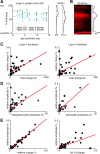Changing microcircuits in the subplate of the developing cortex
- PMID: 22302801
- PMCID: PMC3517995
- DOI: 10.1523/JNEUROSCI.4748-11.2012
Changing microcircuits in the subplate of the developing cortex
Abstract
Subplate neurons (SPNs) are a population of neurons in the mammalian cerebral cortex that exist predominantly in the prenatal and early postnatal period. Loss of SPNs prevents the functional maturation of the cerebral cortex. SPNs receive subcortical input from the thalamus and relay this information to the developing cortical plate and thereby can influence cortical activity in a feedforward manner. Little is known about potential feedback projections from the cortical plate to SPNs. Thus, we investigated the spatial distribution of intracortical synaptic inputs to SPNs in vitro in mouse auditory cortex by photostimulation. We find that SPNs fell into two broad classes based on their distinct spatial patterns of synaptic inputs. The first class of SPNs receives inputs from only deep cortical layers, while the second class of SPNs receives inputs from deep as well as superficial layers including layer 4. We find that superficial cortical inputs to SPNs emerge in the second postnatal week and that SPNs that receive superficial cortical input are located more superficially than those that do not. Our data thus suggest that distinct circuits are present in the subplate and that, while SPNs participate in an early feedforward circuit, they are also involved in a feedback circuit at older ages. Together, our results show that SPNs are tightly integrated into the developing thalamocortical and intracortical circuit. The feedback projections from the cortical plate might enable SPNs to amplify thalamic inputs to SPNs.
Figures









Similar articles
-
Differential signaling to subplate neurons by spatially specific silent synapses in developing auditory cortex.J Neurosci. 2014 Jun 25;34(26):8855-64. doi: 10.1523/JNEUROSCI.0233-14.2014. J Neurosci. 2014. PMID: 24966385 Free PMC article.
-
Transient microcircuits formed by subplate neurons and their role in functional development of thalamocortical connections.Neuroreport. 2004 Oct 5;15(14):2149-53. doi: 10.1097/00001756-200410050-00001. Neuroreport. 2004. PMID: 15371723 Review.
-
Functional excitatory microcircuits in neonatal cortex connect thalamus and layer 4.J Neurosci. 2009 Dec 9;29(49):15479-88. doi: 10.1523/JNEUROSCI.4471-09.2009. J Neurosci. 2009. PMID: 20007472 Free PMC article.
-
The subplate and early cortical circuits.Annu Rev Neurosci. 2010;33:23-48. doi: 10.1146/annurev-neuro-060909-153244. Annu Rev Neurosci. 2010. PMID: 20201645 Review.
-
Molecularly Defined Subplate Neurons Project Both to Thalamocortical Recipient Layers and Thalamus.Cereb Cortex. 2017 Oct 1;27(10):4759-4768. doi: 10.1093/cercor/bhw271. Cereb Cortex. 2017. PMID: 27655928 Free PMC article.
Cited by
-
A role for silent synapses in the development of the pathway from layer 2/3 to 5 pyramidal cells in the neocortex.J Neurosci. 2012 Sep 19;32(38):13085-99. doi: 10.1523/JNEUROSCI.1262-12.2012. J Neurosci. 2012. PMID: 22993426 Free PMC article.
-
Early retinal deprivation crossmodally alters nascent subplate circuits and activity in the auditory cortex during the precritical period.Cereb Cortex. 2023 Jul 5;33(14):9038-9053. doi: 10.1093/cercor/bhad180. Cereb Cortex. 2023. PMID: 37259176 Free PMC article.
-
Extracortical origin of some murine subplate cell populations.Proc Natl Acad Sci U S A. 2014 Jun 10;111(23):8613-8. doi: 10.1073/pnas.1323816111. Epub 2014 Apr 28. Proc Natl Acad Sci U S A. 2014. PMID: 24778253 Free PMC article.
-
Investigating the effects of chronic perinatal alcohol and combined nicotine and alcohol exposure on dopaminergic and non-dopaminergic neurons in the VTA.Sci Rep. 2021 Apr 22;11(1):8706. doi: 10.1038/s41598-021-88221-8. Sci Rep. 2021. PMID: 33888815 Free PMC article.
-
Neonatal Hypoxia-Ischemia Causes Functional Circuit Changes in Subplate Neurons.Cereb Cortex. 2019 Feb 1;29(2):765-776. doi: 10.1093/cercor/bhx358. Cereb Cortex. 2019. PMID: 29365081 Free PMC article.
References
-
- Cruikshank SJ, Rose HJ, Metherate R. Auditory thalamocortical synaptic transmission in vitro. J Neurophysiol. 2002;87:361–384. - PubMed
Publication types
MeSH terms
Grants and funding
LinkOut - more resources
Full Text Sources
Molecular Biology Databases
